As you’ve seen over the last four weeks, there is a ton that can be done with crochet. You never have to make the same style twice with all the possibilities crochet offers! Last week, we talked about textured crochet, which is often a thick, bulky style that evokes images of sitting by a ski lodge fireplace. Though it might be hard to believe in the still-frozen Northeast, the winter is finally beginning to thaw, and in anticipation of springtime, I’m going to take you to the opposite end of the spectrum today and talk about lace.
Crocheted lace is a wide-ranging topic. Some people think anything that has enough openwork and thin enough yarn or thread counts as lace, while others see it only as tatted thread.
Today, I want to give you a brief introduction to four common types of crocheted lace: broomstick lace, filet crochet, hairpin lace, and Solomon’s Knot.
Broomstick Lace gets its name from the original tools used to create it back in the 1800s. While now crafters often use large knitting needles, like our size 50 Speed Stix, the craft began by utilizing the long, narrow top of the broomstick, along with a crochet hook. It is also known as “jiffy lace” or “peacock eye crochet” because of how speedily it works up and the texture it creates. For a detailed tutorial on broomstick lace, click here.
The lacy yet structured material this stitch creates makes it ideal for springtime blankets and shawls or unique lightweight garments. This Broomstick Lace Shell, made with LB Collection Cashmere, is a perfect project to practice your technique and create a unique garment to wear as the weather gets warmer.
Filet crochet utilizes the more traditional crochet stitches, using stitch placement to create the lacy effect. Filet is often worked with a chart that indicates whether each stitch should be an “open mesh” or a “solid mesh”. Open mesh stitches will create your lace, and are made by skipping the next stitch, making one chain, and making a double crochet in the next stitch. The closed mesh stitches will simply be two double crochet stitches for each solid-colored block. Though filet might sound complicated and seem like a lot of work when looking at the accompanying chart, like most yarn-crafting techniques, it becomes very natural and rhythmic once you get going.
To create this traditional European northern star filet crochet motif, take a look at this Stitchfinder pattern, which features a chart and detailed instructions.
 Hairpin lace is another lace technique requiring an extra tool, but that will create a truly unique stitch pattern. To create this variety of lace, you will use a hairpin lace tool, which features two narrow parallel bars, and wrap your yarn around the bars in loops, crocheting the loops together in the “spine” down the middle. You can find a detailed tutorial on hairpin lace here. Once you’ve learned the technique, check out the great patterns available on Ravelry, including this Striped Hairpin Shawl, originally featured in Crochet World Magazine, and made in Wool-Ease.
Hairpin lace is another lace technique requiring an extra tool, but that will create a truly unique stitch pattern. To create this variety of lace, you will use a hairpin lace tool, which features two narrow parallel bars, and wrap your yarn around the bars in loops, crocheting the loops together in the “spine” down the middle. You can find a detailed tutorial on hairpin lace here. Once you’ve learned the technique, check out the great patterns available on Ravelry, including this Striped Hairpin Shawl, originally featured in Crochet World Magazine, and made in Wool-Ease.
 Finally, if you’re looking for one last way to create a unique, lacy-effect in your crochet, try the Solomon’s Knot stitch, which is made up simply of single crochet stitches and chains with extended loops. Once you have the basics down from this tutorial, you’ll be able to make a lacy scarf or rectangle shawl in no time flat!
Finally, if you’re looking for one last way to create a unique, lacy-effect in your crochet, try the Solomon’s Knot stitch, which is made up simply of single crochet stitches and chains with extended loops. Once you have the basics down from this tutorial, you’ll be able to make a lacy scarf or rectangle shawl in no time flat!
Which lacy technique are you most excited to try as spring rolls in?
Related Links:
You must be <a href="https://blog.lionbrand.com/wp-login.php?redirect_to=https%3A%2F%2Fblog.lionbrand.com%2Fadvanced-crochet-techniques-part-four-lace%2F">logged in</a> to post a comment.
DINESH XAVIER
so beautiful love all those patterns
pls visit http://abtexams.blogspot.in/
Rayna Thompson
I like the Delta Lace technique also. It’s an openwork lace using stitches in a special triangular joining. It was very popular in Germany years ago, but is being rediscovered.